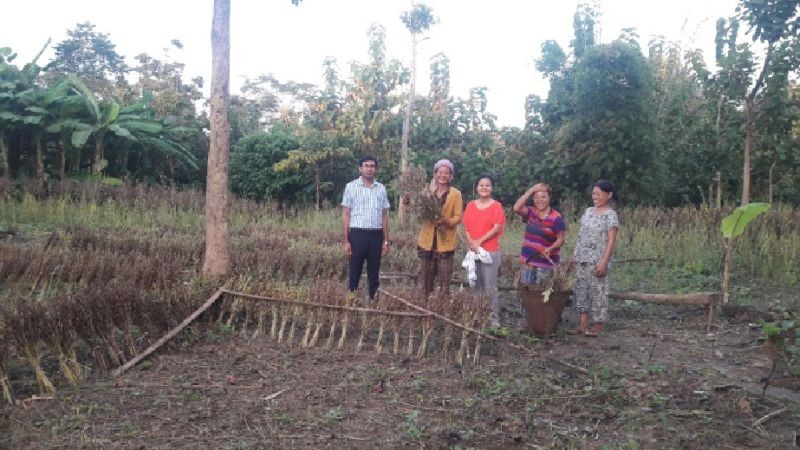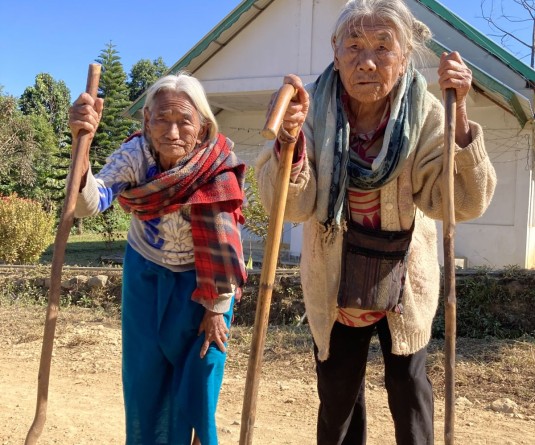Promotion of sesame varieties in Nagaland by ICAR Nagaland Centre, Medziphema

Sesame (Sesamum indicum L.) is considered to be the oldest indigenous oilseed crop, with the longest history of cultivation in India. India is the largest producer of sesame in the world with a production of 746 MTha-1 (FAOSTAT, 2020), playing a substantial role by contributing to 12.40 % of the world’s production. India exported 312.62 lakh tonnes of sesame seed and oil, amounting to 3920 crores in the year 2018-19 (Directorate General of Commercial Intelligence and Statistics, Kolkata). It is extensively grown in Gujarat, West Bengal, Karnataka, Rajasthan, Madhya Pradesh, Tamil Nadu, Andhra Pradesh and Maharashtra. Sesame is commonly known as til (in Hindi, Assamese), ellu (in Malayalam, Tamil), tal (in Gujarati), rasi (in Odia) (NMOOP). Sesame is known for its high oil content, aroma and flavor thereby, earning its name as the queen of oilseeds (Johanson et al., 1979).
Sesame is one of the most important oilseed crops not only in mainland India but also in North Eastern India, comprising of eight states. It is cultivated in marginal lands and borders of field crop for its seed. It is mainly of two distinct types, the black and the white. Colour can also vary from red to rose or from brown or grey. It is used in the preparation of many cuisines and snacks. In Assam, it is an integral part of ‘pitha’ which is a sweet, prepared with rice batter. In Nagaland, it is consumed in roasted form as snack and also in the preparation of pork and chutneys. ‘Daineiiong’, a dal curry with sesame as the key ingredient is a part of the Garo Khasi cuisine. Til ladoos which is basically sesame balls made with jaggery is savoured in all parts of NE India. It is used as toppings in cakes and cookies and also for garnishing salads and curries.
Sesame seeds are used in a wide array of food and also for industrial uses such as cosmetics, lubricants and pharmaceutical purposes (Bedigian, 2004). Seeds are composed of 36-63% oil, 18-25% protein, 14-16% carbohydrates and 5-7% minerals (Anastasi et al., 2015). In an era where synthetic antioxidants are used extensively, there is an increasing demand for more natural products in the global market. Sesame fulfils that criteria as it contains antioxidants such as sesamin, sesamolin and sesamol and thus in that, it is more stable than vegetable oil. Due to presence of antioxidants, sesame seeds are also known as ‘the seeds of immortality’.
Sesame is a short duration crop, requiring low input of resources and can be grown under rainfed, irrigated, dryland or residual moisture conditions. It grows well on stored soil moisture with minimal irrigation and can produce good yields under high temperature (Bennet and Wood, 1995). With the current change in climate and drought conditions, there is a need to grow drought resistant crops, which includes sesame.
With increasing health awareness and its use in a plethora of food products as well as for cosmetics and pharmaceutical purposes, there is a demand for organically produced sesame. The increase in consumption of organic sesame along with healthy eating trend has led to an increase of demand in the global market. Organic sesame gets more recognition and premium in the market. In addition to this, it also maintains soil health and overall, the environment.
The climate of the North East region is well suited for the crop to flourish (Debnath et al., 2015). Some of the improved varieties of sesame such as Cums-17, Prachi, Amrit, Nagaland Local, Bahubeti, Nagaon T-1 Nagaland Local, are promoted by ICAR RC for NEH Region, Nagaland centre in Nagaland to enhance the productivity as well as area covered under sesame cultivation. Moreover, the crop is covered under Minimum Support Price (MSP) scheme of the Government.
Given the many significance of sesame cultivation, farmers in North East India should be given knowledge through workshops and field visits on ‘Know-how’ of organic sesame cultivation which includes use of bio-agents, FYM, vermicompost, resistant varieties, intercropping of sesame with green gram or cluster bean, etc. to combat issues relating to pest and diseases, soil fertility and weed management. The farmers should be encouraged for adopting organic production technologies whilst ensuring a good stable yield and have a significant share in trade as well as result in farmers bagging good returns.
References:
1. Food and Agriculture Organization Statistical Databases (FAOSTAT). http://faostat.fao.org/ (accessed on 5 February 2020).
2. Directorate General of Commercial Intelligence and Statistics, Kolkata, Ministry of Trade and Commerce, Government of India.
3. National Mission on Oilseeds and Oil Palm (NMOOP), Ministry of Agriculture and Farmers Welfare, Government of India.
4. Johnson, L. A., Suleiman, T. M. and Lusas, E. W. (1979). Sesame Protein: A Review and Prospectus. J. Am. Oil Chem. Soc., 56: 463–468.
5. Bedigian, D. (2004). History and lore of sesame in Southwest Asia. Econ. Bot., 58: 329–353.
6. Anastasi, U., Sortino, O., Tuttobene, R., Gresta, F., Giuffre, A. M. and Santonoceto, C. (2015). Agronomic performance and grain quality of sesame (Sesamum indicum L.) landraces and improved varieties grown in a Mediterranean environment. Genet Resour Crop Evol., DOI 10.100/s10722-015-0338-z.
7. Bennett, M. R. and Wood, I. M. (eds) (1995). Proceedings of First Australian Sesame Workshop, Northern Territory Department of Primary Industries and Fisheries, Darwin.
8. Debnath, P., Singh, R., Feroze, S. M. and Sarkar, A. (2015). Study on growth and instability of Sesame in North-Eastern hill region of India. Economis Affairs, 60(2): 193-196.
Article contributed by Harendra Verma, Sakuonuo Theunuo , L K Baishya, D J Rajkhowa (ICAR research complex for NEH Region, Nagaland Centre, Medziphema) and Amit Kumar (ICAR research complex for NEH Region, Umiam, Meghalaya)




